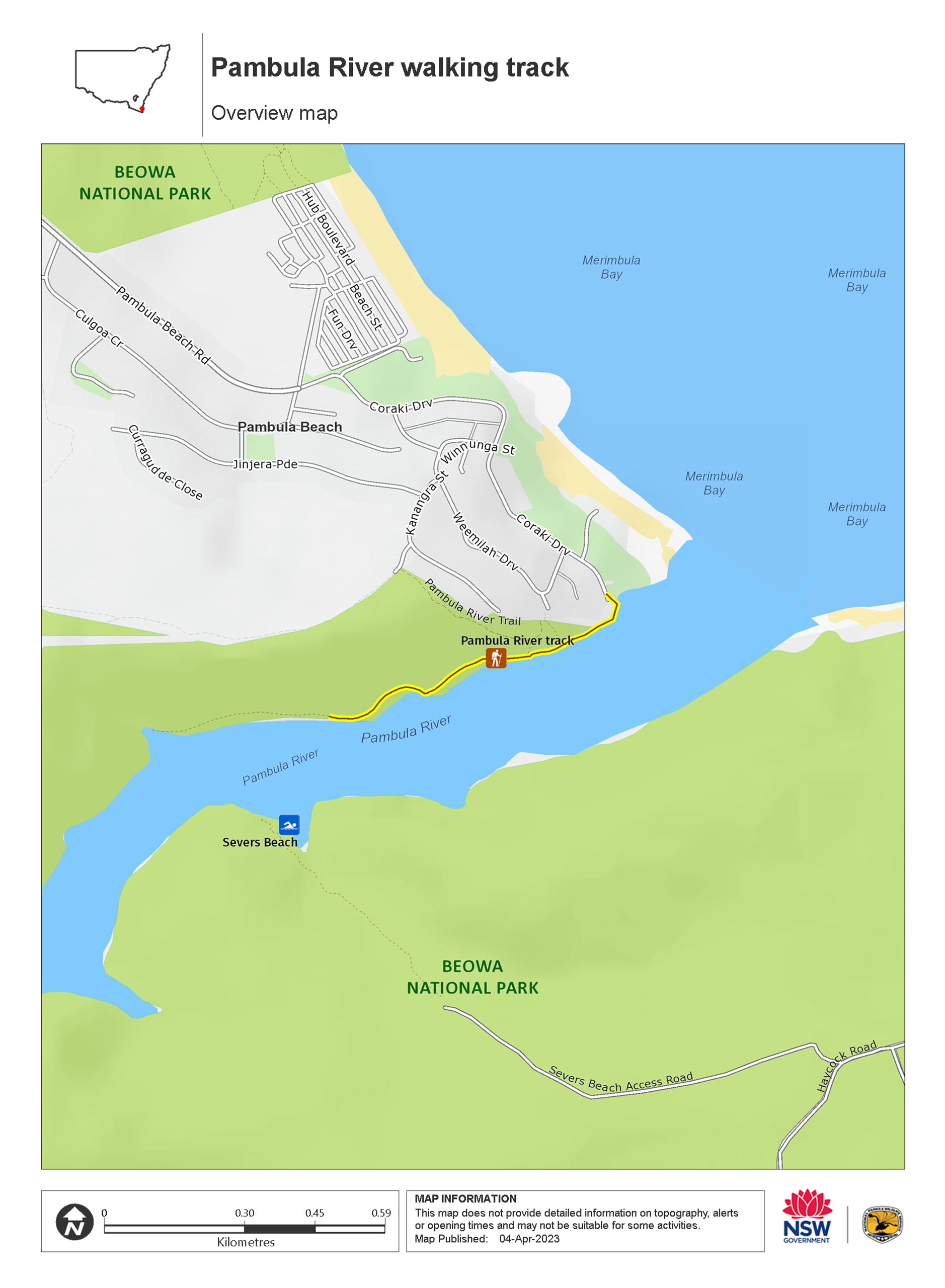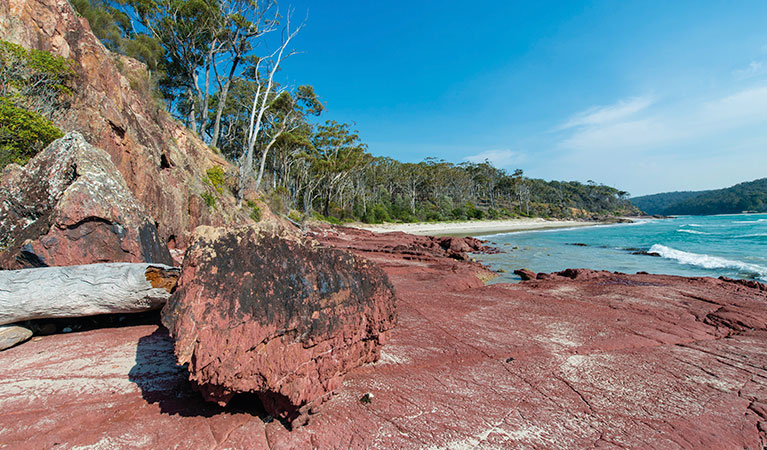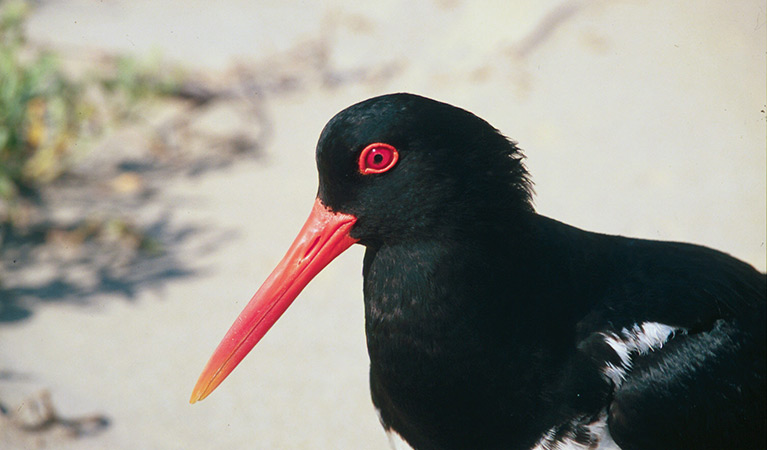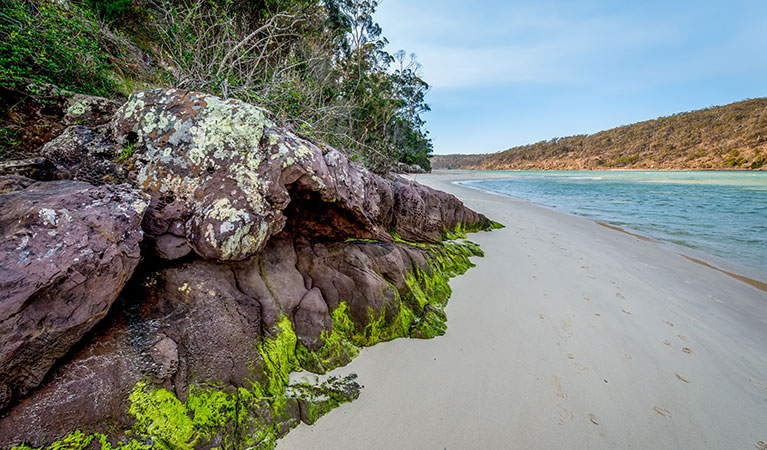Pambula River walking track
Pambula-Haycock area in Beowa National Park
Overview
Pambula River walking track in Beowa National Park is a short walk that offers scenic views along the coast and whale watching and birdwatching from the lookout.
- Where
- Pambula-Haycock area in Beowa National Park in South Coast
- Distance
- 1km return
- Time suggested
- 20 - 40min
- Grade
- Grade 4
- Please note
- It’s a good idea to put sunscreen on before you set out and remember to take a hat and drinking water.
- Remember to take your binoculars if you want to go bird watching or whale watching.
- Strong rips and currents may be present at this beach – take care in the water and please supervise children at all times.
If you’re after a feeling of tranquillity, this peaceful walk meanders gently along the Pambula riverbank. Offering charming river vistas, it winds through coastal woodland to a lookout with scenic views across Severs Beach and Pambula River.
Pambula River walking track is a relaxing stroll, ideal for families and nature-lovers keen to take in the unspoilt natural beauty of Beowa National Park.
The track starts at the mouth of Pambula River, offering lovely views of Haycock Point. Information signs dotted along the way highlight the area’s rich cultural history.
Bring your binoculars to see a wide variety of birdlife including sea eagles, and you may even spot dolphins or stingrays in the crystal clear waters of the river. Pack a thermos and enjoy a break at the secluded inlet before retracing your steps.
Map

Map legend

Local alerts
For the latest updates on fires, closures and other alerts in this area, see https://uat.nswparks.cloud/things-to-do/walking-tracks/pambula-river-walking-track/local-alerts
General enquiries
- National Parks Contact Centre
- 7am to 7pm daily
- 1300 072 757 (13000 PARKS) for the cost of a local call within Australia excluding mobiles
- parks.info@environment.nsw.gov.au
Park info
- in the Pambula-Haycock area of Beowa National Park in the South Coast region
The Pambula-Haycock area of Beowa National Park is always open but may have to close at times due to poor weather or fire danger.
Visitor info
All the practical information you need to know about Pambula River walking track.
Maps and downloads
Learn more
Pambula River walking track is in Pambula-Haycock area. Here are just some of the reasons why this park is special:
Aboriginal culture

The Yuin People are the Traditional Owners and Custodians of Beowa National Park and they have a long and complex relationship with the coastal environment. Some of the best preserved mounded middens on the east coast of Australia are found in the park along the Pambula River. These middens contain the shells of oysters, mussels and sometimes the bones of sea and land mammals—collected by Aboriginal people from the rock platforms, reefs and estuaries along the park’s coastline.
- Severs Beach Severs Beach, in Beowa National Park in the whale watching town of Eden on NSW’s Sapphire Coast, offers Aboriginal heritage, fishing, beach walks and more.
- Traditional weaving workshop: Beowa Get creative on a traditional weaving workshop in Beowa National Park, halfway between Pambula and Eden. Learn Aboriginal weaving techniques and see how these ancient skills carry a strong connection to Aboriginal culture.
Rocks tell a story

The park’s stunning rock formations, inlets and headlands are the result of extensive geological folding. Most of Beowa National Park lies on red, brown and green shales, sandstones, siltstones and quartzites. These were formed in the Devonian period around 360 million years ago, before dinosaurs roamed the earth. You can see these rock types exposed along the cliffs and headlands. The Devonian period is known as The Age of Fishes and internationally-significant fish fossils have been found in several places along the park’s coastline.
- Haycock Point to Barmouth Beach walking track The walk from Haycock Point to Barmouth Beach in Beowa National Park takes in whale watching, scenic coastal views, wildlife and birdwatching opportunities.
- Pambula River kayaking tour Experience Beowa National Park from the crystal-clear waters of the Pambula River on this exciting guided kayaking tour with Navigate Expeditions.
Refuge for threatened species

Several threatened species take refuge in the Pambula-Haycock area. North of Pambula River there's an important population of yellow-bellied gliders—listen carefully for their trademark crackles and shrieks. Around 50 native mammals and nearly 150 species of birds have been recorded in Beowa National Park. This includes 1 critically endangered bird, 4 endangered animal species and 25 vulnerable species.
- Haycock Point to Barmouth Beach walking track The walk from Haycock Point to Barmouth Beach in Beowa National Park takes in whale watching, scenic coastal views, wildlife and birdwatching opportunities.
- Pambula River kayaking tour Experience Beowa National Park from the crystal-clear waters of the Pambula River on this exciting guided kayaking tour with Navigate Expeditions.
Plants and animals protected in this park
Animals
-

Australian pelican (Pelecanus conspicillatus)
The curious pelican is Australia’s largest flying bird and has the longest bill of any bird in the world. These Australian birds are found throughout Australian waterways and the pelican uses its throat pouch to trawl for fish. Pelicans breed all year round, congregating in large colonies on secluded beaches and islands.
-

Australian fur seal (Arctocephalus pusillus doriferus)
The largest fur seal, Australian fur seals are found in isolated rocky outcrops and islands along the NSW coast. They come ashore to form breeding colonies and can often be seen at Barunguba Montague Island Nature Reserve.

